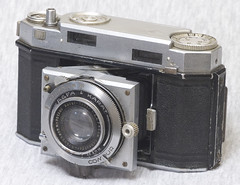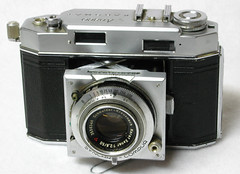Isolette
The Agfa Jsolettes is a strut-folding medium format camera made by Agfa from 1938 until 1950. This folder first came on the market as the Isorette but had a name change to Jsolette (pronounced Isolette) quite soon. There a 2 distinct models the early one and the later (post WW2) one.
Contents
Jsolette early model
The first Karat has an unusual looking rounded cast aluminum body covered with a durable black synthetic material. The top cover is also rounded; both it and the flat bottom cover are painted black. The collapsible front plate, supported by four scissors struts, has an Art Deco style insert that has the shutter & f/stop settings. On the cast top cover is the shutter release and sliding time exposure lock, a Galilean tube viewfinder, a window for the internal frame counter, and the film advance knob, which interlocks with the Agfa self-cocking shutter for double exposure prevention. Also on the top cover are two strap lugs, and a release button to extend the lens standard, which locks in place. The lens standard release to allow the collapsing of the camera is on the left front of thew camera.
- Year of release: 1936
- Film Format: 35mm 12 exp in Rapid cassette
- Shutter: Agfa Automat B 25 50 100 (self cocking)
- Lens: Igestar 6.3/50 (three elements)
- Aperture: 6.3 to 22
- Viewfinder: optical direct vision viewfinder
- Flash: None
Karat 6.3
Similar to the Karat 6.3, the Karat has a larger viewfinder, an external frame counter on the top cover, and a simplified front plate. The lens settings are now on the lens bezel instead of the front plate, and the shutter time exposure lock is relocated to the front, between the top cover and the body. The camera now lacks strap lugs.
- Year of release: 1938
- Film Format: 35mm 12 exp in Rapid cassette
- Shutter: Agfa Automat B 25 50 100 (self cocking)
- Lens: Igestar 6.3/55 (three elements)
- Aperture: 6.3 to 22
- Viewfinder: optical direct vision viewfinder
- Flash: None
Karat 4.5
Similar to the Karat 6.3, the Karat 4.5's most noticeable difference is the use of brushed aluminum top and bottom covers. This model has an improved lens when compared to the two earlier models.
- Year of release: 1938
- Film Format: 35mm 12 exp in Rapid cassette
- Shutter: prontor B 25-125 (self cocking)
- Lens: Oppar 4.5/55 (four elements)
- Aperture: 4.5 to 32
- Viewfinder: optical direct vision viewfinder
- Flash: None
Karat 3.5
The last of the rounded body Karats. Similar to the Karat 4.5, the Karat 3.5's most significant difference is the use of Deckel's Compur and Gauthier's Prontor shutters. As these shutters are not self-cocking, a simple but ingenious method is used to remind the user to cock the shutter before shooting: when cocked, the shutter cocking lever is clearly visible in the viewfinder. The Karat 3.5 originally featured a 5cm f/3.5 Solinar lens; after the war, this was changed to the less expensive 55mm f/3.5 Apotar lens. Early Karat 3.5 models had a cast aluminum top cover with strap lugs and an aperture plate attached to the front lens standard. Later models had stamped covers and aperture scales on the lens bezel.

|
| late pre-war Agfa Karat 3.5 by Jack Hufnagel (Image rights) |
- Year of release: 1938
- Film Format: 35mm 12 exp in Rapid cassette
- Shutter: Compur-Rapid B 1-500; Compur B 1-300; Prontor B 1-250; Prontor S 1-300
- Lens: Agfa Solinar 3.5/50 (pre-war, 4 elements) or Agfa Apotar 3.5/55 (post-war, 3 elements); both front cell focusing
- Aperture: 3.5 to 32
- Viewfinder: optical direct vision viewfinder
- Flash: Models with Prontor S
Karat 12 / Karat 2.8

|
| Agfa Karat 12 by Jack Hufnagel (Image rights) |
The Karat 2.8 was the first of the second series of Agfa Karats. It was later called the Karat 12 to differentiate it from the newer Karat 36. The lens standard and bellows arrangement are basically identical to the Karat 3.5, while the body is entirely new. The Karat 12 has a combined viewfinder/rangefinder and a lever wind. The unusual rangefinder, different from most, shifted the entire upper and lower halves of the viewfinder image when focusing. The film advance lever, which now cocks the shutter, is also unusual in that it operates in the opposite direction (front to back), similar to the later Alpa reflexes. Another upgrade to the Rapid series is a depth-of-field dial located on the top cover where a rewind knob would be on a traditional 35mm camera, and a film reminder dial, located above the right viewfinder window. The film counter has been moved to the right side of the camera, and shutter time exposure lock and lens release button have been relocated as well. Post-war models have a mushroom shaped shutter release.
Sources vary as to the introduction of the Karat 12, most stating either 1941 or 1945. The example shown here has a pre-war Schneider Xenar lens dating from September of 1935, indicating that the Karat 12 was probably in production well before 1941. At any rate, due to the war, introducing a new consumer camera as late as 1941 seems unlikely.
Note: post-war Karats of this model with Schneider lenses did not use the normal Schneider lens serial number sequence, instead using a low five digit number.
- Year of release: 1941?
- Film Format: 35mm 12 exp in Rapid cassette
- Shutter: Compur B 1-300; Compur-Rapid B 1-500
- Lens: Schneider-Kreuanach Xenar 2.8/50 (five elements); unit focusing
- Aperture: 2.8 to 16
- Viewfinder: Split image Rangefinder
- Flash: Some with Compur-Rapid
Karat 36
With the Karat 36, the series moved from the Rapid cassettes to the Kodak 35mm cartridge, though the Karat 12 remained in production for several more years. Outwardly nearly identical to the Karat 12, the most notable differences were: a film rewind knob replacing the depth-of-field dial (which now replaces the film reminder dial) on the top cover, a rewind button on the bottom cover, a folding articulated film advance lever, elimination of the lens release lever (the body mounted lens release lever now performs that function), an accessory shoe, and a shutter time exposure lock that rotates rather than slides.
Later models of the Karat 36 replaced the folding articulated advance lever extension with a non-folding lever with a larger cylindrical knob, eliminated the shutter time exposure lock, replaced the top depth-of-field dial with a more modern depth-of-field scale on the front lens standard, and have a shorter shutter release.
The Karat 36's top engravings varied significantly over the years.
The Ansco Karomat were re-badged versions of the Karat 36 cameras produced for the American Market. In 1953, it sold for $164US (over $1200 in 2007 US dollars - these were not cheap cameras!) At the same time, a comparable Contax IIA cost $440, and a comparable Leica IIIc cost $385.
- Year of release: 1948
- Film Format: 35mm
- Shutter: Compur-Rapid B 1-500; Synchro-Compur B 1-500
- Lens: Agfa Solinar 2.8/50 (four elements); Agfa Solagon 2.0/50; Rodenstock Heligon 2.0/50; Schneider Xenon 2.0/50 (all six elements)
- Aperture: 2.0 or 2.8 to 16
- Viewfinder: optical viewfinder with superimposed rangefinder
- Flash: X- , V- and M-synchronization

|

|

|
| late model Ansco Karomat 36 (1951) | Agfa Karat 36 (1952) with Schneider-Kreuznach Karat Xenon 1:2/50 lens | |

|
| early model Agfa Karat 36 (1949) Jack Hufnagel (Image rights) |
Karat IV
The Karat IV upgrades the Karat 36 with a more conventional superimposed rangefinder and revised top cover.
- Film Format: 35mm
- Shutter: Prontor-SVS
- Lens: Agfa Solinar 2.8/50 (four elements); Agfa Solagon 2.0/50; Rodenstock Heligon 2.0/50; Schneider Xenon 2.0/50 (all six elements)
- Aperture: 2.8 to 16
- Viewfinder: optical viewfinder with superimposed rangefinder
- Flash: X- , V- and M-synchronization

|
| Agfa Karat IV by dbroglin (Image rights) |
References
Bibliography
Original documents
- McKeowns, Price Guide to Antique & Classic Cameras, 12th Edition 2005.